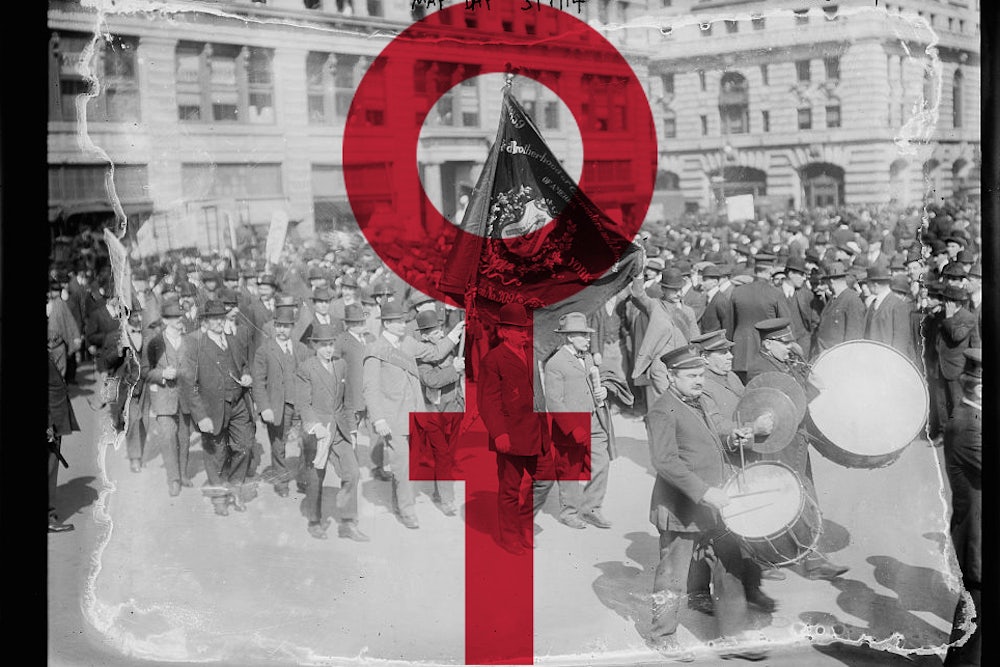Today, the organizers behind the International Women’s Strike will march in New York City’s May Day parade. The IWS faction will wear red, in solidarity with both workers and women. The marching bloc is open to any feminist: You do not need to be affiliated with any union or organization to join them. You can find them on the southwest corner of Washington Square Park at 12:30 PM, or on the northwest corner of Union Square at 4 PM. As Sarah Leonard of The Nation says, it’s “the first bloc like this in a long time.”
The IWS-NYC is here to help the left transcend its gender issues. Last month, Bernie Sanders stumped for mayoral candidate Heath Mello in Omaha, Nebraska. During his time in the state legislature, Mello had supported numerous abortion restrictions, including voting to ban abortions after 20 weeks and to impose new screening requirements. Sanders’s support of Mello, along with the rest of the Democratic Party, revived accusations that the left is willing to compromise on women’s rights in the pursuit of more “universal” goals. It has also revived the tired notion that the left’s most active supporters are men. The Mello incident represents, in Leonard’s term, a kind of “gender oblivion” that only a re-commitment to the feminist history and principles behind American leftism can repair.
The caricature of the left being composed of “Bernie Bros” has been perpetuated in the national media since the 2016 Democratic primary, and has led people to believe that women are not involved in the new wave of leftist politics in the United States. This is not true, despite what Gloria Steinem might tell you. (In fact, younger women supported Sanders in the primary, just as younger men did.)
The International Women’s Strike brought out women of all kinds in New York City in March, and today they will show out in fulsome numbers again. IWS-NYC will march today alongside allied causes. Their “coalition partners” include Brandworkers, Laundry Workers Center, Immigrant Worker Justice, Enlace, and the immigrant advocacy group ICE-FREE NYC. Rossana Rodriguez of the Laundry Workers Center emphasizes that, “When immigrants, women, the LGBTQ community, workers, and poor people are under attack, we must fight back and organize.”
The International Women’s Day Strike asked women to join the feminism of the 99 percent, the feminism that does not align with the “lean-in” or “boss” feminism of Cheryl Sandberg, Thinx’s Miki Agrawal, or Girlboss author Sophia Amoruso. As the New Republic reported then, feminism cannot be about CEOs while real women are suffering under the inequality that flourishes in our economic system. As Kate Griffiths of IWS-NYC says, “We oppose the boss feminism that tells women we can all get ahead if we work hard enough. Not everyone can be a boss—being represented in a boardroom isn’t feminism.”
Lydia Tomlin of the Restaurant Opportunity Center and New York Worker Center Federation says that she is marching on May Day for “all of us workers,” meaning “immigrants, women, LGBTQ, people of color.” Without the “us” of the labor force, she asks, “who will make NYC run?” While women strive to keep communities together—facing the double bind of stagnant wages and a weak social safety net—U.S. Immigration and Customs Enforcement (ICE) preys on immigrant women. As Oscar Diaz-Jacuinde from ICE-FREE NYC says, we live with “a militarized police force that criminalizes, incarcerates, and systematically collaborates to deport our loved ones.”
Unjust working conditions, threats to women’s health care, and discrimination against immigrants and people of color weigh upon American women. The IWS-NYC bloc at today’s march represents the continued mission of “renewed radicalism, solidarity, and internationalism” that the International Women’s Strike fostered. The May Day parade offers an opportunity for women to reassert their commitment to the labor-conscious activism of the Women’s Strike. The movement began long ago, and will continue long after the parade has stopped. A woman’s work is never done.
